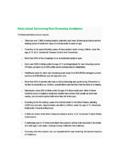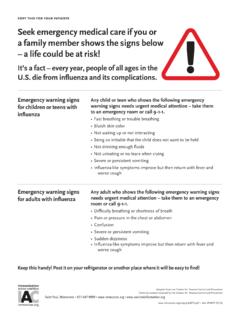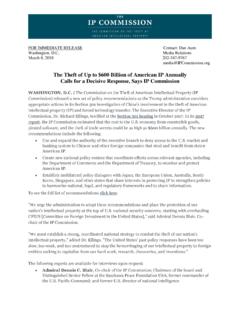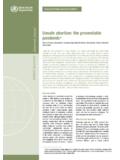Transcription of Chapter 1
1 Chapter 1 Burden: mortality, morbidity and risk factors Chapter 1. Burden: mortality, morbidity and risk factors This Chapter reviews the current burden and trends of NCDs and the risk factors. It also provides the latest estimates on the number, rates and causes of global deaths from NCDs and the prevalence of the most important related risk factors. A description of the methods used to produce these estimates is provided in Annex 1. Data are presented in two ways: according to the six WHO geographical regions1. and by the four World Bank income A listing of countries according to the WHO regions and World Bank income groups in 2008 is in Annex 2.
2 Maps showing the global distribution of NCD- related mortality and selected risk factors are presented in Annex 3, along with the individual country estimates for NCD mortality and selected risk factors presented in Annex 4. NCD deaths are projected to Mortality increase by 15% globally A total of 57 million deaths occurred in the world during 2008; 36 million (63%) were due to NCDs, between 2010. principally cardiovascular diseases, diabetes, cancer and chronic respiratory diseases (1). Nearly and 2020. The 80% of these NCD deaths (29 million) occurred in low- and middle-income countries. NCDs are the most frequent causes of death in most countries in the Americas, the Eastern Mediterranean, greatest increases Europe, South-East Asia, and the Western Pacific.
3 In the African Region, there are still more will be in Africa, deaths from infectious diseases than NCDs. Even there, however, the prevalence of NCDs is the Eastern rising rapidly and is projected to cause almost three-quarters as many deaths as communicable, Mediterranean, maternal, perinatal, and nutritional diseases by 2020, and to exceed them as the most common and South-East causes of death by 2030 (2). Asia, where they WHO projections show that NCDs will be responsible for a significantly increased total number of deaths will increase by in the next decade. NCD deaths are projected to increase by 15% globally between 2010 and 2020 (to over 20%.)
4 44 million deaths). The greatest increases will be in the WHO regions of Africa, South-East Asia and the Eastern Mediterranean, where they will increase by over 20%. In contrast, in the European Region, WHO. estimates there will be no increase. In the African Region, NCDs will cause around million deaths by 2020. The regions that are projected to have the greatest total number of NCD deaths in 2020 are South- East Asia ( million deaths) and the Western Pacific ( million deaths) (2). With the exception of the African Region, NCD mortality exceeds that of communicable, maternal, perinatal and nutritional conditions combined.
5 For men in the European Region, deaths from NCDs are estimated to be 13 times higher than these other causes combined, and for men in the Western Pacific Region they are estimated to be eight times higher (Figure 1). In 2008, the overall NCD age-standardized death rates in low- and middle-income countries were 756. per 100 000 for males and 565 per 100 000 for females respectively 65% and 85% higher than for men and women in high-income countries. Age-standardized NCD mortality rates for all ages were highest in the African Region for males (844 per 100 000) and for females (724 per 100 000). The leading causes of NCD deaths in 2008 were: cardiovascular diseases (17 million deaths, or 48%.)
6 Of NCD deaths); cancers ( million, or 21% of NCD deaths); and respiratory diseases, including asthma and chronic obstructive pulmonary disease (COPD), ( million). Diabetes caused an additional million deaths. Over 80% of cardiovascular and diabetes deaths, and almost 90% of deaths from COPD, occurred in low- and middle-income countries. Behavioural risk factors, including tobacco use, physical inactivity, and unhealthy diet, are responsible for about 80% of coronary heart disease and 1. The six WHO regions are the African Region, the Region of the Americas, the South-East Asia Region, the European Region, the Eastern Mediterranean Region and the Western Pacific Region.
7 2. The World Bank income groups categorize nations according to average gross national income (GNI) per capita into low- income, lower-middle-income, upper-middle-income and high-income countries. Income groups for the year 2008 were used in this report. 9. Chapter 1 Burden: mortality, morbidity and risk factors Figure 1. Total deaths by broad cause group, by WHO Region, World Bank income group and by sex, 2008. 18. 16. Males Females 14. 12. Total deaths (millions). 10. 8. 6. 4. 2. 0. AFR AMR EMR EUR SEAR WPR Low- Lower- Upper- High- AFR AMR EMR EUR SEAR WPR Low- Lower- Upper- High- income middle- middle- income income middle- middle- income income income income income Injuries Noncommunicable Communicable, maternal, perinatal diseases and nutritional conditions (Note: AFR=African Region, AMR=Region of the Americas, EMR= Eastern Mediterranean Region, EUR= European Region, SEAR=South-East Asia Region, WPR=Western Pacific Region).
8 Cerebrovascular disease (3). These important behavioural risk factors of heart disease and stroke are discussed in detail later in this Chapter . More than two thirds of all cancer deaths occur in low- and middle-income countries. Lung, breast, In low- and colorectal, stomach and liver cancers cause the majority of cancer deaths. In high-income countries, middle-income the leading causes of cancer deaths are lung cancer among men and breast cancer among women. In countries, 29% of low- and middle-income countries cancer levels vary according to the prevailing underlying risks. In sub-Saharan Africa, for example, cervical cancer is the leading cause of cancer death among NCD deaths occur women.
9 Risk factors for cancer include the four shared behavioural factors (tobacco use, unhealthy among people diet, insufficient physical activity and the harmful use of alcohol), but infections such as hepatitis under the age of B, hepatitis C (liver cancer), human papillomavirus (HPV; cervical cancer) and Helicobacter pylori 60, compared (stomach cancer) also cause up to 18% of cancer burden (4). In addition, cancers are also caused to 13% in high- by radiation and a variety of environmental and occupational exposures of varying importance, income countries depending on the specific geographical region and cancer site.
10 Premature death is a major consideration when evaluating the impact of NCDs on a given population, with approximately 44% of all NCD deaths occurring before the age of 70. In low- and middle- income countries, a higher proportion (48%) of all NCD deaths are estimated to occur in people under the age of 70, compared with high-income countries (26%). The difference is even more marked for NCD deaths in younger age ranges: in low- and middle-income countries, 29% of NCD. deaths occur among people under the age of 60, compared to 13% in high-income countries. Figure 2 shows the proportion of NCD deaths (in 2008) among people under the age of 70, by cause.
















